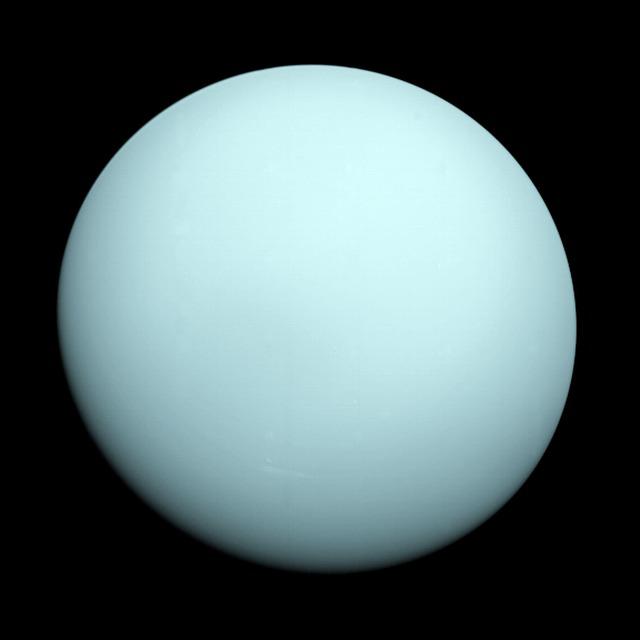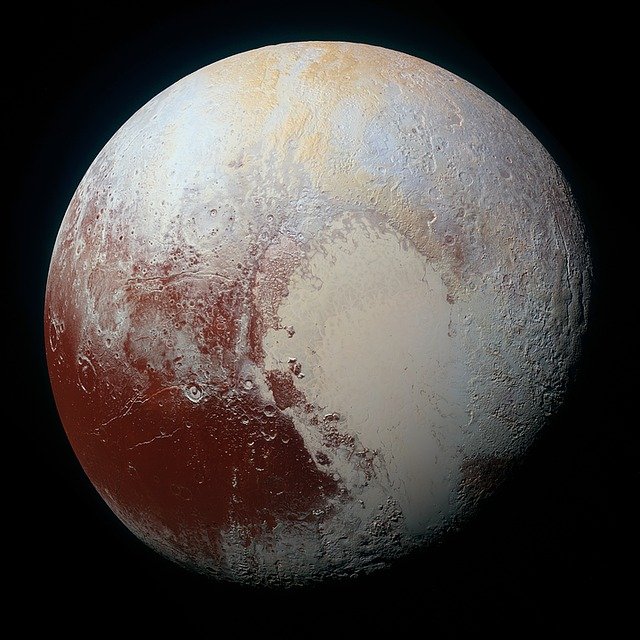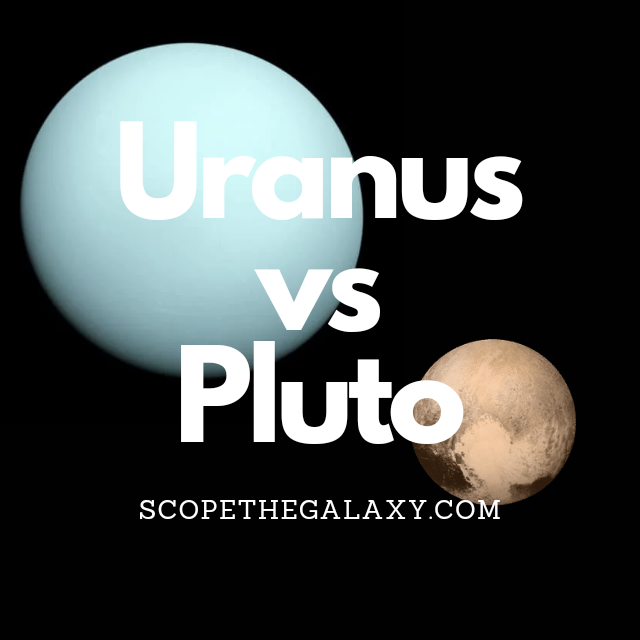*This post may contain affiliate links. This means we may make a commission if you purchase an item using one of our links*
The main difference between Uranus and Pluto is that the former is a cyan blue ice giant composed mostly of gas and ice whereas the latter is a dwarf planet made mostly of rocks and ice. Uranus is much bigger than Pluto where over 25 Pluto sized planets could fit across it and Pluto is tidally locked to one of its moons whilst Uranus is not.
These are a number of other unique and distinct differences that Uranus and Pluto have so, continue reading for a more thorough understanding of these differences and the odd few similarities between these two.
What Is The Planet Uranus?
Table of Contents

Uranus is the 7th farthest planet from the Sun and the 3rd largest planet in our solar system, coming in at a diameter of 50,724 km. This means that roughly 63 Earth’s could fit inside this ice giant.
In regards to why this cyan blue planet is referred to as an ice giant, it’s down to it’s composition. Uranus is made mostly of methane, ammonia and water with its atmosphere mostly consisting of hydrogen and helium, much like the Sun, and the other giant planets in our solar system.
Due to its distance from the Sun, it takes Uranus 84 years to complete one orbit around the Sun, whereas it’s axial rotation is much faster than even our Earth at 17 hours per rotation.
As a result of its distance from the Sun, ice based composition and faster rotation levels, Uranus is far from an ideal place to live in or even have the potential to support life.
Its base temperature is generally a chilling -190 to -200 degrees Celsius and its rocky core, although hot, is still on the cooler side for a large planet sitting around the 5,000 degrees Celsius range.
The planets winds are also very fast often hitting 900 km/h, which is roughly twice that of Earth’s most powerful turbulent wind speeds.
In regards to the moons present surrounding this cyan planet, we’ve discovered 27 small moons orbiting it. Furthermore, it has 13 rings surrounding it which also means Uranus has the most abundant collection of rings surrounding in our solar system, which is even more than Saturn.
One of the Uranus’ most unique features would include the manner in which it rotates around its axis. As opposed to the slightly angled rotation that the likes of Earth, Saturn and most other planets display, Uranus’ axis is positioned at a 98 degree angle.
What this means is this ice giant completes an axial rotation on its side as opposed to the relatively up straight positioning of most of the other planets in our solar system.
What Is The Planet Pluto?

In the past Pluto was the 9th farthest official planet in our solar system however, in 2006 after many debates between astronomers, the International Astronomical Union officially downgraded it to a dwarf planet.
The reason for this downgrade at the time was primarily down to Pluto simply being too small when compared to every other planet and even the moons orbiting these planets. Pluto’s dwarf status is still debated to this day but, for now it remains under this dwarf bracket for a planet
Its diameter for example is only 2,370km, which is a third of Earth’s Moon. With that being said, despite the significant size discrepancy Pluto shows, it still does have more moon like objects orbiting it than Earth and I’m not saying just one more.
In total this terrestrial dwarf planet has 5.
Pluto’s atmosphere consists mostly of molecular nitrogen whilst molecules of methane and carbon monoxide have been observed also. As for its surface, it consist mostly of frozen nitrogen, methane, and carbon monoxide ices.
One of Pluto’s most unique characteristic is that Charon (its largest moon) is tidally locked to it and vice versa, which means that the two essentially orbit each other where, in essence only one side of Charon and one side of Pluto’s surface will face each other at any given time.
Pluto’s temperature is between -222 to -232 degrees Celsius based on how close it gets to the Sun when orbiting it, whilst its core temperature isn’t anything too special sitting around 500 – 1,000 degrees Celsius.
The main reason it’s as cold as it is and has a relatively cold core in comparison to the other planets would be mostly down to its size. A larger size would mean more mass could be compressed at the center which would produce more heat at the core.
Pluto’s orbit is also different from the other main plants in our solar system, following an elliptical orbital path as opposed to the circular path the others take. As a result of its distance from the Sun, Pluto will complete each one of these elliptical cycles around the Sun once every 247.78 years.
Even its rotational cycle is very slow, where one cycle is completed in 157 hours. Another interesting fact is the Pluto’s axial tilt is almost on its side at 57 degrees, similar to Uranus.
Similarities Between Uranus And Pluto
Although different in more ways than they are similar, you can still find some commonalities between Uranus and Pluto. As for what they are it would include the following
- Both planets are orbiting the Sun.
- Both have a hotter central core.
- Both have multiple moons.
- Both are a spherical shape.
- Both have ice on their surfaces.
Differences Between Uranus And Pluto
In regards to the differences between the two, they would include the following.
- Uranus has 13 rings whilst Pluto has 0.
- Pluto completes an orbit around the sun in 247.78 years whereas Uranus does so in 84 years.
- Pluto is tidally locked to one of its moons whereas Uranus is not tidally locked to any of its moons.
- Uranus has 27 moons whilst Pluto only has 5.
- Uranus is far bigger than Pluto with a diameter of 50,724km whereas Pluto is 2,370km in diameter.
- Pluto is colder in general than Uranus with a surface temperature of -222 to -232 degrees Celsius whereas Uranus is around -190 to -200 degrees Celsius. Even when it comes to core temperature Pluto’s is between 500 – 1,000 degrees compared to Uranus’ core temperature of around 5,000.
- One day in Uranus takes 17 hours whereas Pluto completes a rotation in 157 hours.
- Pluto has an axial tilt of 57 degrees whereas Uranus’ tilt is more drastic at 98 degrees.
- Pluto is an ice giant whilst Pluto would be a terrestrial planet.
- Pluto is officially recognised as a dwarf planet whilst Uranus is regarded as a normal planet.
- Uranus has a stronger magnetic field than Pluto, which has been observed to have little to no magnetic field, especially when compared to Uranus.
- Uranus has an axial tilt of 98 degrees as opposed to Pluto’s which is 57 degrees.
Summary
Uranus and Pluto are planets, even if one is an ice giant and the other a dwarf terrestrial planet. Nevertheless, they differ in many ways, whether it be their size, the moons that orbit their and their orbital cycle around.
All in all Pluto and Uranus differ significantly despite the odd few common features that they share and that can be defined based on how they look and how they function out there in space..


